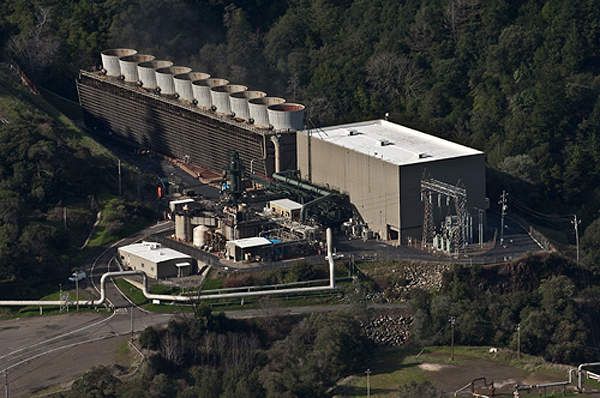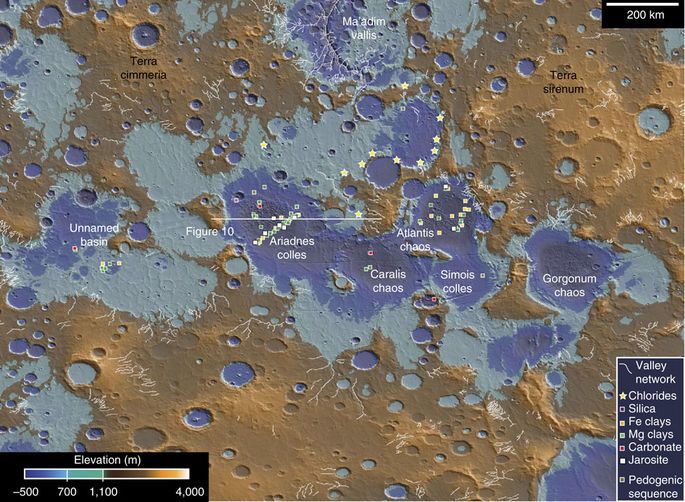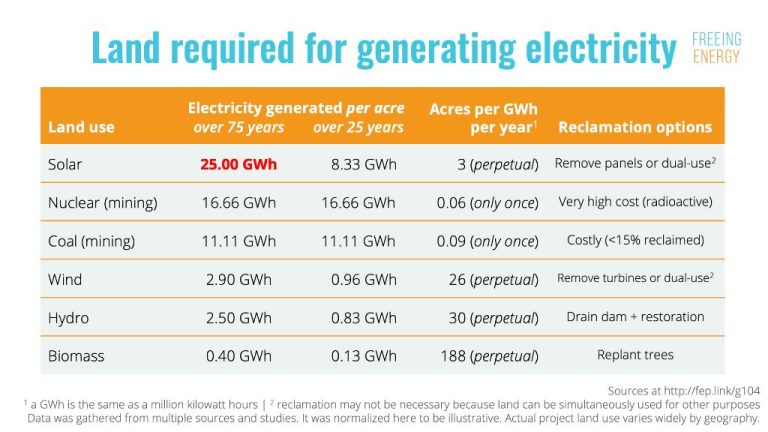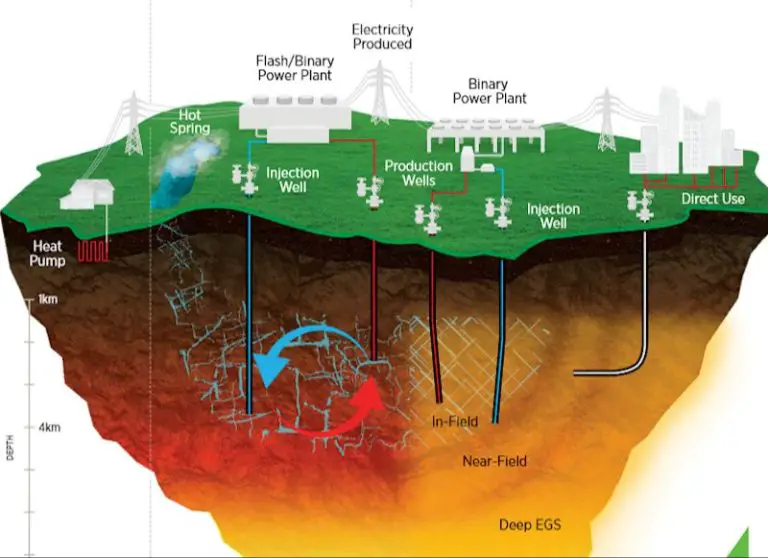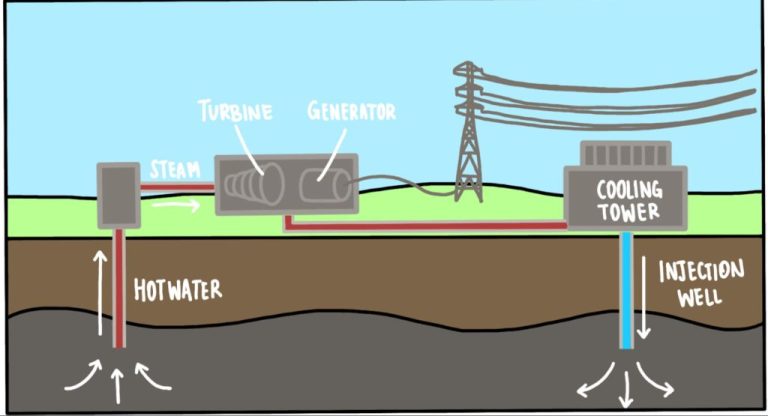What Is High Temperature Geothermal Energy?
What is Geothermal Energy?
Geothermal energy is thermal energy generated and stored inside the Earth. It arises from the original formation of the planet, from radioactive decay of minerals, and from solar energy absorbed at the surface. Geothermal energy in the form of hot springs has been used by humans for millennia for bathing, and now it’s being used to generate electricity.
There are several types of geothermal energy, classified by temperature and depth. Low temperature geothermal is closer to the surface (less than 300 feet) and ranges in temperature from 50-150°F. It can be used for direct heating applications like greenhouses. Medium temperature resources range from 150-300°F and can be used for electricity generation. High temperature geothermal resources are deeper in the Earth (greater than half a mile) and reach temperatures above 300°F. These high temperature reservoirs are the most suitable for generating electricity.
How High Temperature Geothermal Energy Works
High temperature geothermal energy utilizes naturally occurring hot water or steam reservoirs found deep underground to produce electricity. Extremely hot water, reaching temperatures over 150°C, is brought to the surface from depths of 2-4 km through production wells that are drilled into underground reservoirs. This extremely hot water or steam can be used directly or indirectly to drive turbines which power electrical generators.
In a direct system, high pressure steam is piped directly from geothermal reservoirs to turn turbine generator units. The used steam is then condensed and re-injected into the reservoir to be reheated and reused. In a binary system, the hot water from below heats and vaporizes a separate working fluid with a lower boiling point. This vapor is used to turn the turbines, then cooled and condensed back into a liquid and reused repeatedly.
Binary systems are closed-loop systems with minimal emissions. Direct systems release some steam emissions but advanced technologies can reduce this. In either system, the used geothermal fluids are returned to the reservoir, keeping the resource renewable.
Locations with High Temperature Resources
High temperature geothermal resources are found in areas with volcanic and tectonic activity, where hot magma and fluid reservoirs exist closer to the earth’s surface. Prime locations for harnessing high temperature geothermal energy include:
- The western United States, where there are active geothermal fields like The Geysers in northern California and steam resource areas in Nevada.
- The Cascade Mountain Range, where high temperature resources are located in volcanic areas of Oregon, Washington and Idaho.
- The Taupo Volcanic Zone on New Zealand’s north island, home to several productive geothermal fields.
- Iceland, where high temperature hydrothermal systems provide a large share of the country’s electricity and heating.
- The East African Rift Valley system in countries like Kenya and Ethiopia.
- Japan, Indonesia, Mexico and Central America, where geothermal activity occurs along tectonic plate boundaries.
Areas with known high temperature geothermal systems share common geological characteristics like recent volcanic activity, high heat flow and permeable reservoir rocks near the surface. This makes them ideal for generating power from the Earth’s internal heat.
Advantages of High Temperature Geothermal
High temperature geothermal energy has several key advantages over other energy sources:
Zero Emissions – Geothermal energy does not burn fuels, so it produces near zero emissions. This makes it extremely clean and environmentally friendly compared to fossil fuels.
Renewable & Sustainable – Geothermal energy is considered renewable, as heat is continuously produced inside the earth. With proper reservoir management, geothermal resources can provide sustainable energy for thousands of years.
Always Available – Unlike wind and solar which are intermittent, geothermal energy provides constant reliable power 24/7. This gives it an edge over other renewables for grid stability and base load power generation.
Disadvantages & Challenges
While high temperature geothermal energy offers many benefits, it also comes with some drawbacks and obstacles that need to be considered.
One of the biggest disadvantages is the high upfront costs required. Building a geothermal power plant requires significant capital investment for exploration, drilling wells thousands of feet into the earth, and constructing the power generation facilities. This is substantially more expensive than building other types of renewable energy plants.
Another challenge is that suitable geothermal resources are limited to certain locations. Only areas with naturally occurring hot springs or reservoirs of superheated underground water/steam are viable sites. This geographical constraint makes widespread adoption difficult.
There are also potential environmental impacts that need to be managed. The drilling and fluids used can contaminate groundwater if not properly handled. And the pumping out of the heat reservoir over many decades may eventually cool the geothermal resource, making it no longer viable over the long term.
While these downsides exist, they are actively being addressed through technological innovations to lower costs and reduce environmental risks. With further research and development, high temperature geothermal can maximize its advantages while overcoming its current limitations.
High Temperature Geothermal Projects
There are several notable high temperature geothermal projects harnessing 300-400°C resources around the world:
The United States has invested heavily in geothermal plants at The Geysers complex in California which utilizes steam between 235-240°C. Multiple projects have enhanced the capacity here from 600 MW in the 1990s to over 900 MW today.
In Indonesia, the Sarulla project brought online 320 MW of capacity in 2017, tapping into one of the world’s largest geothermal fields with temperatures up to 340°C. The project cost $1.5 billion and provides clean energy to the North Sumatra region.
Iceland has been at the forefront of high temperature geothermal, with their volcano- dotted landscape providing ample heat resources. The Hellisheidi power plant produces over 300 MW from underground waters reaching over 200°C.
In Kenya, the Olkaria geothermal projects utilize 280-310°C resources to provide low-cost, renewable electricity. Olkaria IV added 280 MW in 2014, and Olkaria I in Naivasha was the first privately funded geothermal plant in Africa when it opened in 1981.
Japan operates several productive high temperature geothermal plants like the Hatchobaru plant in Oita Prefecture. With temperatures exceeding 300°C, these projects provide stable baseload power to supplement Japan’s other renewables.
Future Outlook & Innovations
While high temperature geothermal energy currently makes up a small percentage of renewable power generation globally, the future outlook is promising as technology continues to improve. Here are some key areas of innovation and growth projections for high temperature geothermal energy:
Improving Technology
New techniques like Enhanced Geothermal Systems (EGS) are enabling geothermal reservoirs to be developed in areas that lack natural convective hydrothermal resources. EGS works by pumping water into hot, dry rock formations deep underground at high pressures, which creates fractures and improvesconnectivity, allowing the water to capture the rock’s latent heat.
Growth Projections
According to the International Energy Agency (IEA), geothermal generation globally could grow from around 90 terawatt-hours (TWh) in 2019 to more than 200 TWh by 2040 if countries adopt supportive policies and incentives. The IEA projects high temperature geothermal resources alone having the potential to provide around 140 gigawatts (GW) of baseload renewable capacity globally.
With continued technological improvements, declining costs, and growing investment, the future is bright for high temperature geothermal energy to play an expanding role in the global renewable energy mix.
Comparisons to Other Renewables
Compared to other renewable energy sources like solar, wind, and hydroelectric power, high temperature geothermal has some key differences in terms of pros and cons:
Solar: Solar power relies on photovoltaic panels to convert sunlight into electricity. It has very low operating costs once installed, but relatively high upfront installation costs. Solar output depends on sunlight and weather conditions. Geothermal provides constant baseline power regardless of weather or darkness. However, solar can be deployed almost anywhere while high temperature geothermal depends on geological conditions.
Wind: Wind turbines harness kinetic energy from wind to generate power. Wind power can be quickly installed and scaled, but output relies on wind conditions. Geothermal provides steady baseline power while wind fluctuates. However, wind can be deployed in many more locations than geothermal which depends on subterranean heat sources.
Hydroelectric: Dams and turbines convert the energy of flowing water into electricity. It provides low-cost, emissions-free power. However, locations are limited by water resources, and droughts can disrupt output. Geothermal offers an emissions-free baseload power alternative less impacted by weather and climate. But hydroelectric facilities are generally much cheaper to construct than geothermal plants.
Overall, high temperature geothermal provides constant, reliable electricity not dependent on external weather conditions. Its ability to provide baseload power gives it an advantage over intermittent renewables like solar and wind. However, geothermal depends on site-specific underground conditions, so its potential locations are limited compared to wide-scale deployability of solar and wind.
## Key Takeaways
High temperature geothermal energy refers to geothermal resources with temperatures typically above 150°C that can be used to generate electricity. Key takeaways about high temperature geothermal energy include:
-
High temperature geothermal resources are located near boundaries of tectonic plates, volcanic areas, and geologically young formations.
-
High temperature geothermal plants use dry steam, flash, or binary cycle systems to convert the geothermal heat into electricity.
-
Advantages of high temperature geothermal include its ability to provide base load renewable power and its low lifecycle greenhouse gas emissions.
-
Challenges include high upfront costs, technical risks of drilling, location constraints, and managing environmental impacts.
-
Notable high temperature geothermal projects include those at The Geysers in California, Cerro Prieto in Mexico, and Hellisheiði in Iceland.
-
Future innovations aim to increase accessibility through enhanced geothermal systems (EGS) and hybrid power plants.
-
High temperature geothermal competes with solar and wind in terms of costs but provides more reliable baseload power.
Overall, high temperature geothermal is a renewable baseload power source with significant potential, despite needing high initial investments and having geographical limitations.
Further Reading
There are many resources available to learn more about high temperature geothermal energy:
- Reports from the U.S. Department of Energy, such as the Geothermal Technologies Office Annual Report and research on Enhanced Geothermal Systems (EGS). These detail the latest projects, technologies and opportunities in high temperature geothermal in the U.S.
- The Geothermal Energy Association’s website, which provides facts, data, policy information and news related to the geothermal energy industry globally.
- The International Renewable Energy Agency’s (IRENA) Geothermal Power: Technology Brief, which overviews current capacities, costs, and innovations in geothermal energy worldwide.
- The proceedings of the World Geothermal Congress, held every 5 years, which compile the latest geothermal research, case studies, policy analyses and more.
- Scholarly articles published in academic journals such as Geothermics, Renewable & Sustainable Energy Reviews, and the Geothermal Resources Council Transactions.
Additionally, contacting offices of energy departments, renewable energy associations, utility companies, and academic geoscience departments in your region can provide localized resources and perspectives on high temperature geothermal.

